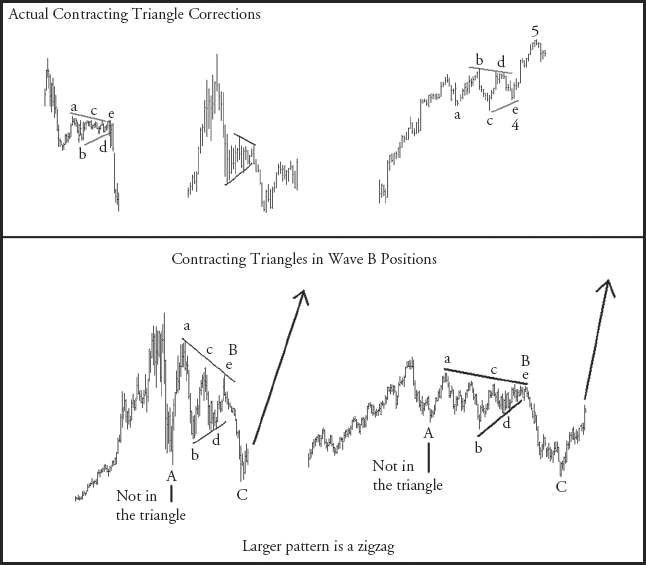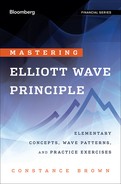Study Flash Cards for the Basic Patterns
These are the Elliott Wave Principle patterns we have studied so far:
1. A simple five-wave pattern.
2. An expanding five-wave pattern.
3. A failure fifth wave.
4. A termination diagonal triangle.
5. A leading diagonal triangle—type 2.
6. A zigzag corrective pattern.
7. A flat corrective pattern.
8. An expanded flat corrective pattern.
9. A contracting triangle corrective pattern.
10. An expanding triangle corrective pattern.
These 10 patterns are in fact the only patterns you need to learn. The intermediate level in the next book will combine these same patterns to explain more complex corrections. As an example the zigzag pattern will sometimes repeat and we then identify it as a double zigzag. But it will just be two zigzag patterns glued together. It is the connector ‘x’ that causes people the greatest trouble. For this reason I bumped all that more advanced discussion into the Intermediate graduate work.
Because the extending five-wave patterns are so difficult to know just where you are within them, I have a different chart style in Figure 5.1. It shows these extending patterns must end with a specific number of swings. The number of waves in an impulse wave is five.
FIGURE 5.1 CVX, Monthly
Source: Aerodynamic Investments Inc., © 1996–2012, Advanced Trading Seminar, www.aeroinvest.com; TradeStation.
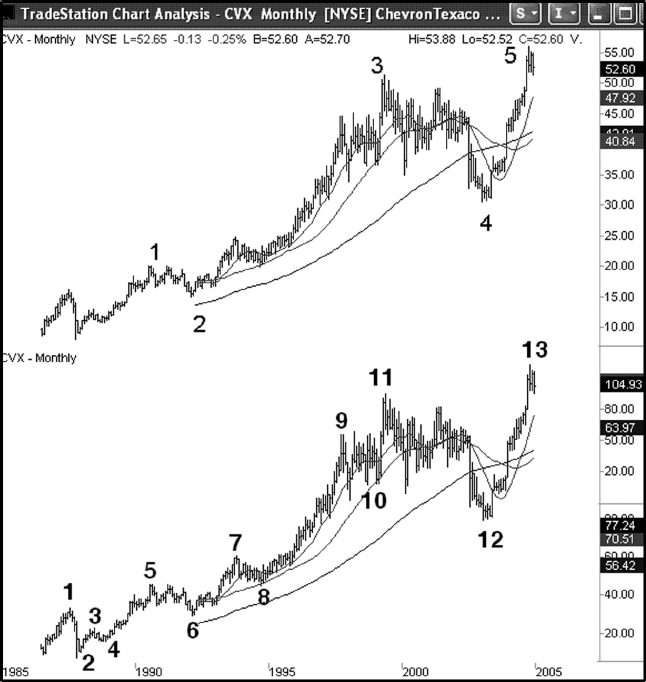
If it extends further you must add another four swings in total, always adding a pair of swings in the front and a pair on the end. The first pair will become waves 1 and 2. The last pair must satisfy waves 4 and 5. Therefore, nine swings may end an extending five-wave pattern, but 9 plus 4 is 13. The series grows by the following set; 5, 9, 13, 17, 21, and so on. Figure 5.1 shows you conventional wave labels and then a continuous way to count waves. The only thing to keep in mind is to remember waves must be complete to label them. The number of swings is counted rather than the subdivisions using conventional Elliott notation. The point here is that 11 will never end an impulse wave. So count first; name patterns later.
In Figure 5.2 are sample zigzag patterns in the context of making a correction in bull and bear markets. The chart on the right is also a zigzag pattern in point-and-figure charting. The line diagrams for these patterns are to the left of the first bar charts.
FIGURE 5.2 Zigzag Corrective Pattern
Source: Aerodynamic Investments Inc., © 1996–2012, Advanced Trading Seminar, www.aeroinvest.com; TradeStation.
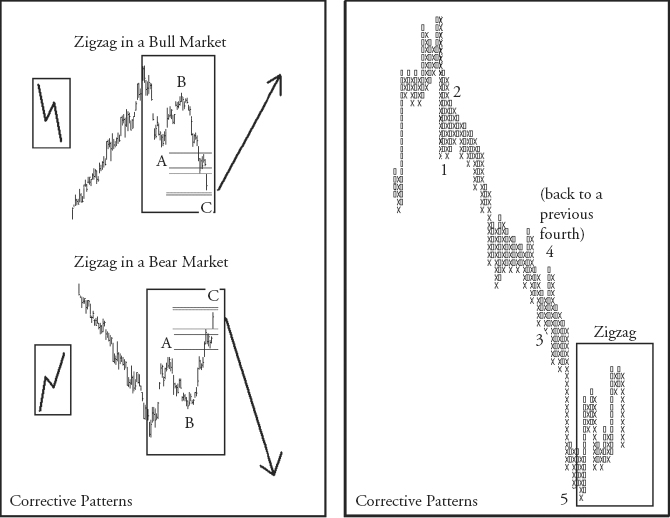
The problem with learning the corrective wave patterns is recognizing the same pattern in different sizes. The internals all meet the criteria that define the specific pattern, but then the person learning is unable to see the pattern when the size changes. Therefore, Figure 5.3 offers examples copied directly from market charts of various time horizons. Learn to recognize the feel of the pattern more than a set of rules.
FIGURE 5.3 Zigzag Corrective Patterns
Source: Aerodynamic Investments Inc., © 1996–2012, Advanced Trading Seminar, www.aeroinvest.com; TradeStation.
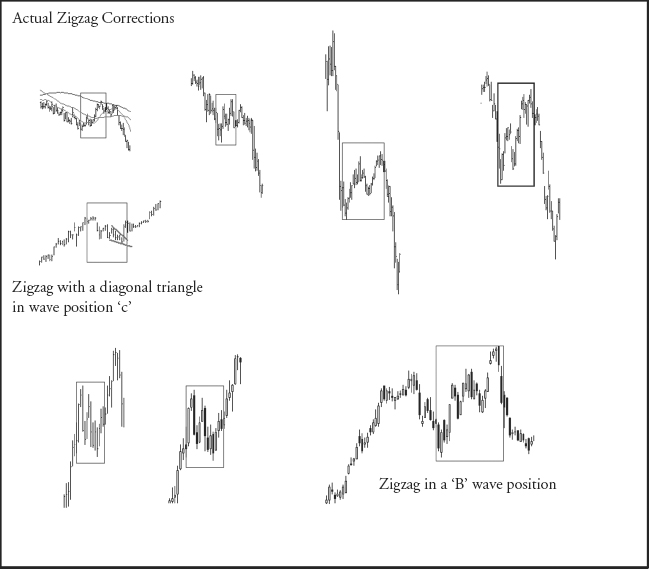
The expanded flat is far more difficult to learn than the Flat. In Figure 5.4 the expanded flat that developed in the S&P 500 is perfection. But do not expect such clarity in all situations.
FIGURE 5.4 Flat and Expanded Flat Corrective Patterns
Source: Aerodynamic Investments Inc., © 1996–2012, Advanced Trading Seminar, www.aeroinvest.com; TradeStation.
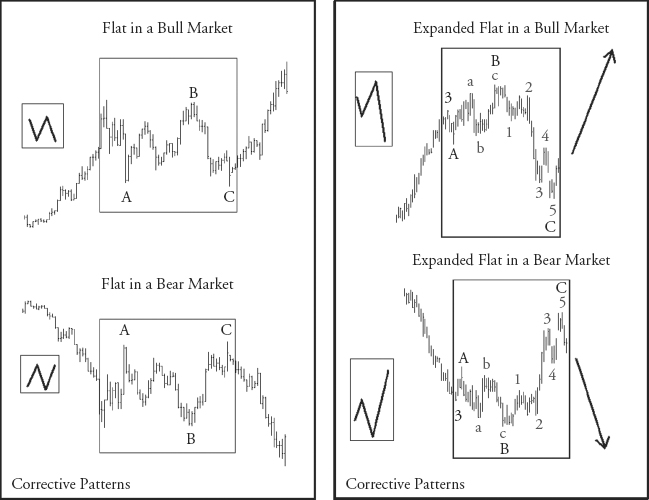
Figure 5.5 has captured various expanded flats and flats so you have a reference card of various markets and time horizons to compare. They all demonstrate these patterns in various ways. As an example, there is an expanded flat within a ‘B’ wave position that is within a larger corrective pattern we know as a flat. This is a good introduction to what we will be developing for you when we begin the intermediate material in the next book, Advanced Elliott Wave Analysis: Complex Patterns, Intermarket Relationships, and Global Cash Flow Analysis.
FIGURE 5.5 Flat and Expanded Flat Corrective Patterns
Source: Aerodynamic Investments Inc., © 1996–2012, Advanced Trading Seminar, www.aeroinvest.com; TradeStation.
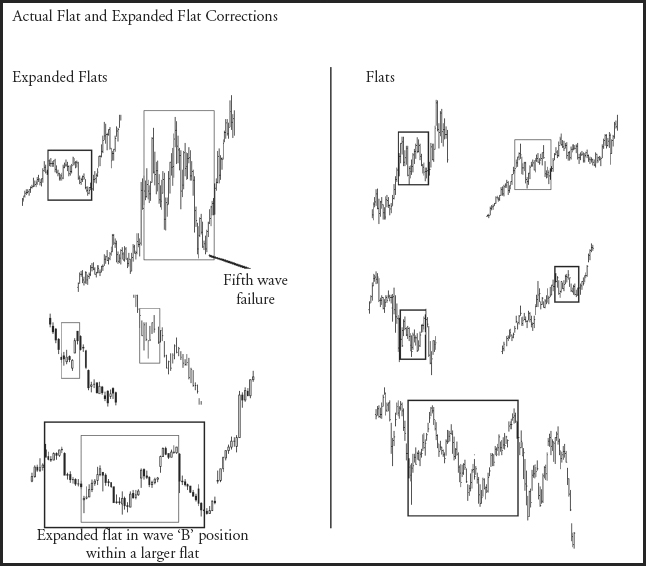
Some of these patterns require many bars to develop and some need minimal bars to be correctly identified, since they all carry the same look. It will not take you long to know these patterns if you study short horizon charts. That way you have the opportunity to study many patterns in shorter periods of time. Scroll from the older date forward. Do not try to call the pattern in real time to start. That is beyond the basic skill level you have for just for a short while.
Figure 5.6 gives you actual market data for the corrective patterns we call contracting triangles. Particular care has been given to find the triangles that our industry often identifies incorrectly. That is when the first leg in the coiling pattern is five waves by itself. That is not where the triangle begins. It starts in the next swing. All corrections that begin with five waves will develop into zigzag patterns. Therefore these triangles fall within wave ‘B’ as the middle leg of the larger zigzag corrections.
FIGURE 5.6 Contracting Triangle Corrective Patterns
Source: Aerodynamic Investments Inc., © 1996–2012, Advanced Trading Seminar, www.aeroinvest.com; TradeStation.
